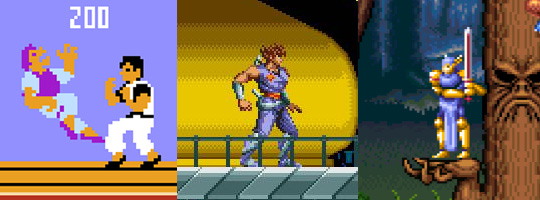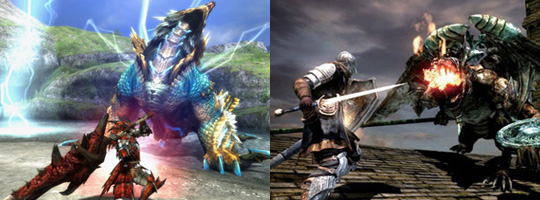On Genre Distinctions

A fascinating subject that came up in the comments of my post about animation issues in Kingdom Of Amalur was about the key distinctions between beat 'em ups and its "cousin" genres. I wanted to quickly elaborate on those splits and changes and touch on the essence of each of them from a game play point of view. I mostly want to answer the question "What is a Beat 'Em Up?" out loud so we can all agree and move on. Haha! But first let's talk about a really important spectrum; the danger level of an individual attack.

On the left side of the spectrum in zone A are generally low danger levels on individual attacks. The animations come out quickly, do fatal damage, and your character is dumped back into their neutral state almost immediately. On the right side of the spectrum in zone C we have the opposite. Animations happen very slowly, do low levels of damage, and take a very long time to follow through and finish, dangerously prolonging the time it takes to dump your character back into their neutral state. The attacks of zone B are somewhere in the middle of these two extremes. While a combat-heavy action game can certainly contain attack mechanics in all of these zones, it turns out that most of them utilize attacks from one of the zones exclusively. I've coined a couple terms to describe the games that fit snugly into a zone in this way:
The Zone A Game: Kill 'Em Ups

I call games whose attacks fit primarily into zone A "Kill 'Em Ups". Examples of kill 'em ups are Kung Fu, Strider, and Actraiser. I made a point to use Kung Fu as an example because many people declare that to be the first beat 'em up. It took me some thought to realize why that has always seemed inherently incorrect, but now I know; it's because it is built on zone A attacks! The effective strategy of a kill 'em up is to move defensively and avoid many enemies that zip about arbitrarily while striking rapidly all over the play space. Your character tends to die on few mistakes in these games because of the highly lethal nature of attacks (enemies in kill 'em ups tend to kill on contact), but since enemies are simple and also tend to die very quickly, their presence is required in large numbers. The distinct absence of repeat aggression against any one target (with the exception of bosses) is what really sets them apart from their cousins. Ultimately, most kill 'em ups brilliantly reward near-blind aggression, which has almost everything to do with their birth in the arcade environment. A fascinating thought experiment is comparing the millisecond to millisecond gameplay of kill 'em ups with that of shoot 'em ups.
The Zone C Game: Grind 'Em Ups

I call games whose attacks fit primarily into zone C "Grind 'Em Ups". Examples of grind 'em ups are Monster Hunter and Dark/Demon Souls. Now I realize "grind" is a pejorative term in games but I most certainly don't mean it that way here. I personally find these games thrilling and highly rewarding! Because of the almost absolute emphasis on zone C attacks, the intent of a grind 'em up is not only to very carefully position your character defensively around very few enemies, but to also meticulously monitor the fight for the perfect moment to strike. Every decision you make in a grind 'em up is an important decision, and you are constantly in danger when fighting because of the highly punitive properties of your own attacks. There aren't a lot of games built on this philosophy (on purpose at least; there are plenty of games with zone C attacks that are just badly implemented), because making a game this punitive enjoyable is a deep, dark, black magic. But ask any passionate grind 'em up player what they love about grind 'em ups and they'll probably indicate to you a sense of honesty, legitimate reward, and overwhelming satisfaction. The secret to zone C satisfaction is that when you fuck up you know it's your fault, and when you accomplish something you know you really accomplished something...which is also a distinctly arcade game sensibility!
The Zone B Game: Beat 'Em Ups

Hopefully the distinction makes sense at this point. Beat 'em ups like Devil May Cry/God Of War/Bayonetta are comprised primarily of zone B attacks, which rest nicely in the middle of zone A and C. The intent in beat 'em ups is to get your character within striking distance and perform repeated attacks of varying meaning against against 1 to X enemies, while monitoring the movements and attacks of 1 to X additional enemies all focused on you. Defense is a less involved tactic than it is in the two other types of games, and it's really more about rhythm and timing. What's most interesting about beat 'em ups place on the spectrum is that it affords them this huge and compelling variety of attack mechanics and for me personally, that's where all the juice is. Kill 'em ups need 1 or 2 attack mechanics tops, grind 'em ups can get by with a small handful of attack mechanics, but beat 'em ups would lose a lot of what makes them special if they lost the expression that emerges from having lots of attack options available at any given point.
Trivial Aesthetic Differences

I just needed to comment on this real quick because it irks me on a designer level; the weapon a character holds (or doesn't) does not determine the game's genre! I say this mostly because there is this nebulous and erroneous distinction between "beat 'em up" and "hack and slash". The main problem is that sometimes when people say "hack and slash" they are referring to Devil May Cry, and sometimes they are referring to Diablo, and sometimes they are referring to Skyrim, and sometimes blah blah blah. I understand why this was perpetuated into the early 90's; the first 4 seminal beat 'em ups were about violently pounding the lung meat out of gangsters in the streets with your bare fists. But as well all should know by now, Golden Axe (large melee weapons) is as much a beat 'em up as River City Ransom (bare fists and small melee weapons), which is as much a beat 'em up as Otogi (swords and magic), which is as much a beat 'em up as Bayonetta (ice skates, electric bomb claws, and high-heel shotguns). Haha! In any case, I hope this goes a long way to answering the question "what is a beat 'em up?". For me it became a lot clearer when I started holding it up to these other game types, which is a very helpful exercise to perform whether you're trying to answer an obsessive-compulsive question or not. ;)
-
Nahil
-
Ideas
-
Nels Anderson
-
Tom
-
Michael J
-
Godahl